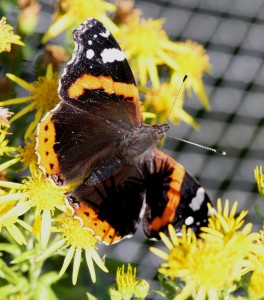 The first signs of spring means different things to different people. The swallow is a major contender, perhaps closely followed by the house martin, particularly if the latter nests under the eaves of your house. Whilst the sand martin is just about the earliest, a much larger bird, the osprey, is generally the first. To other people the first snowdrops herald the spring or even the butterbur that can now be found in full flower on roadside verges. The verges near Udale Bay or on Loch Ness side at Dores are now a creamy mass with the large blossoms of butterbur. However, like many readers, it is perhaps the first, long awaited, butterfly to flutter around the garden. Such was the case for me this year but it was also a surprise as it was not the species I would have expected.
The first signs of spring means different things to different people. The swallow is a major contender, perhaps closely followed by the house martin, particularly if the latter nests under the eaves of your house. Whilst the sand martin is just about the earliest, a much larger bird, the osprey, is generally the first. To other people the first snowdrops herald the spring or even the butterbur that can now be found in full flower on roadside verges. The verges near Udale Bay or on Loch Ness side at Dores are now a creamy mass with the large blossoms of butterbur. However, like many readers, it is perhaps the first, long awaited, butterfly to flutter around the garden. Such was the case for me this year but it was also a surprise as it was not the species I would have expected.
Up until a few years ago the only contender for the first spring butterfly would have been the then ubiquitous small tortoiseshell. Indeed, they were the only butterflies that hibernated as adults in the Highlands. Then came the unexpected as, in September 2002, there was a sudden and dramatic influx of migrant peacock butterflies from the continent. Weather maps suggest it was from the north, possibly Scandinavia, and they appeared in numbers in eastern Inverness-shire and Moray. Then what was even more surprising was that they overwintered as adults and appeared the next spring. People could not believe that the small tortoiseshell was joined on the nectar sources such as Buddleias and Sedums by the comparatively flamboyant peacock. The peacock is indeed impressive with the large “eye” shaped markings on the wings. These eyes can warn off predators as, if the peacock is at rest with its wings closed, when the wings suddenly open the eyes flash and look like danger and the predator, whether it be small birds, such as blue tits, or a mouse backs off. As if this was not enough to warn off predators, when the butterflies wings rub together when it is disturbed they make a hissing noise. The sequel to the invasion in 2002 was that the peacocks are now here to stay and they are now regularly seen in gardens on nectar sources.
Then came rumours that down south in southern England red admirals were beginning to over winter as adults and flying the next spring. Up until then, whilst the red admirals were common, they were only from migrants, each year in varying numbers, from the continent. At first the over-wintering butterflies were only found in southern parts of England but then the early spring records started coming from further north. In the last few years there were even reports for the Highlands for either red admirals being seen in hibernation or so early in the spring they could not have been migrants. That was my surprise, and delight, this year as on 18th March there was the first butterfly of the year, a red admiral flying around the house in a temperature that was only 6 degrees, albeit sunny. So this could mean that this spring there could be three species of butterflies at the first nectar sources such as early flowering heathers, scabious etc. The three are all members of the old groups name of “aristocrats” because of their outstanding colouration and size. These are the small tortoiseshell, the peacock and now joined by the red admiral. All the caterpillars of these three butterflies will eat nettles so make sure you leave a corner of the garden where you allow these to grow and you will be rewarded by more of these aristocrats of the butterfly world.
Tags: highland wildlife
